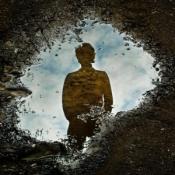 Although posttraumatic stress (PTSD) tends to be the issue that most often comes to mind when we consider trauma, there are a number of other responses, including depression, anxiety, substance abuse, and difficulties in relationships. Most of these other issues are embedded within the constellation of PTSD and will make more sense as we understand the condition. Many people think of combat veterans when they think of PTSD. Indeed, much of what we know about trauma its effects is a result of the experiences of Vietnam veterans. While trauma responses of course existed prior to the Vietnam war, there had not been a whole lot of focus on understanding traumatic reactions (Herman, 1992).
Although posttraumatic stress (PTSD) tends to be the issue that most often comes to mind when we consider trauma, there are a number of other responses, including depression, anxiety, substance abuse, and difficulties in relationships. Most of these other issues are embedded within the constellation of PTSD and will make more sense as we understand the condition. Many people think of combat veterans when they think of PTSD. Indeed, much of what we know about trauma its effects is a result of the experiences of Vietnam veterans. While trauma responses of course existed prior to the Vietnam war, there had not been a whole lot of focus on understanding traumatic reactions (Herman, 1992).
Many different types of events can be traumatic. Trauma responses can follow any major change or disruption in a person’s life. Some examples that may come to mind include a serious and potentially life-threatening accident, assault, natural disaster, or combat. Other experiences can be traumatic as well, including surviving or witnessing a crime; physical, verbal, emotional, or sexual abuse; bullying; or even a big relocation.
In the time immediately following a trauma, many people have experiences of PTSD. In some cases, those experiences decrease over time and the person naturally recovers. It can be helpful to think of PTSD as a process where something got in the way of that natural process of recovery. A therapist works to determine what has interfered with routine recovery. In each trauma experience, the factors that can influence the responses vary. As a result, there are as many individual examples of things that can block a smooth recovery as there are individuals with PTSD (Resick, et al., 2008).
However, there are commonalities among PTSD experiences. Several categories of experiences tend to follow a traumatic event. In particular, the experiences of PTSD fall into four clusters (APA, 2013).
The first cluster is the reexperiencing (intrusion) of the event in some way. This may include nightmares about the event or other scary dreams, flashbacks (acting or feeling as if the incident is recurring), and intrusive memories that suddenly pop into mind. Individuals might have intrusive memories when there is something in the environment to remind them of the traumatic event (including anniversaries of the event) or even when there are no reminders. Common times to have these memories are before falling asleep, when relaxing, or when bored.
Therapeutic work serves to not only provide relief from this cycle, but to eradicate the interruption in the recovery process.
A second set of experiences concern arousal, which refers to a constant alarm signal. As might be expected, when reminded of the event, a person with PTSD is likely to experience strong emotions. Accompanying these feelings are physical reactions similar to the ones we might experience coming face to face with a saber-toothed tiger. Indicators of arousal experiences include problems falling or staying asleep, irritability or outbursts of anger, difficulty concentrating, startle reactions such as jumping at noises, or always feeling on guard or looking over our shoulder even in the absence of an external reason.
The third cluster of trauma experiences is avoidance of reminders of the event. Although it is important to point out this avoidance is often not deliberate, a natural reaction to intrusive memories and strong emotional reactions is the urge to push these thoughts and feelings away. We might avoid places or people who remind us of the event. Some people avoid watching certain television programs or turn off the TV altogether. Some people avoid reading the newspaper or watching the news. We might avoid thinking about the event and letting ourselves fully experience our feelings about it. There might be certain sights, sounds, or smells we find ourselves avoiding or escaping from because they remind us of the event.
Sometimes people with PTSD have trouble remembering all or part of the event. Other times, people with PTSD feel numb and cut off from the world around them. This feeling of detachment or numbness is another form of avoidance. Sometimes it is described as feeling as though the person is watching life from behind glass.
Someone navigating things like reexperiencing, hyperarousal, and avoidance may begin to develop reconstructed beliefs about their life, the world, others, and themselves. It makes sense this set of experiences on a day-to-day basis might begin to reshape our view of not only ourselves and others, but about the world how it works. This refers to the fourth cluster of PTSD, the negative cognitive (or mood-based) shifts that can occur following traumatic experiences.
Conclusion
With this overview of trauma and how the PTSD cycle tends to maintain itself, we can begin to better understand how traumatic events can lead to the types of trauma reactions and PTSD experiences we often see (Resick, et al., 2008). Each of these four components contributes to the others in a cyclical way that interrupts the natural recovery process following a traumatic event. Therapeutic work serves to not only provide relief from this cycle, but to eradicate the interruption in the recovery process.
If you would like help in recovering from trauma (or your responses to it), contact a therapist who specializes in posttraumatic stress-related issues.
References:
- American Psychiatric Association. (2013). Diagnostic and statistical manual of mental disorders (5th, text rev.). Washington, DC: Author.
- Herman, J. L. (1992). Trauma and recovery. New York: Basic Books.
- Resick, P.A., Monson, C.M., & Chard, K.M. (2008). Cognitive processing therapy: Veteran/military version. Washington, DC: U.S. Department of Veterans Affairs.

The preceding article was solely written by the author named above. Any views and opinions expressed are not necessarily shared by GoodTherapy.org. Questions or concerns about the preceding article can be directed to the author or posted as a comment below.

 Psychotherapy for Your Body: The Role of Somatic Psychology Today
Psychotherapy for Your Body: The Role of Somatic Psychology Today 'I’m Still Not Good Enough': When Trauma's Old Ghosts Resurface
'I’m Still Not Good Enough': When Trauma's Old Ghosts Resurface ‘Why Do I Do That?’ The Silent Sway of the Threat Response
‘Why Do I Do That?’ The Silent Sway of the Threat Response

